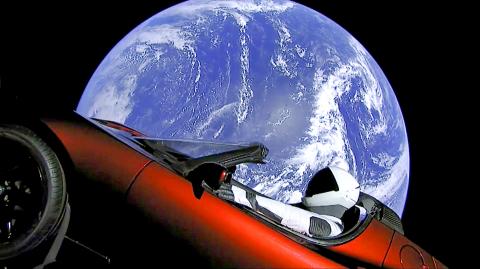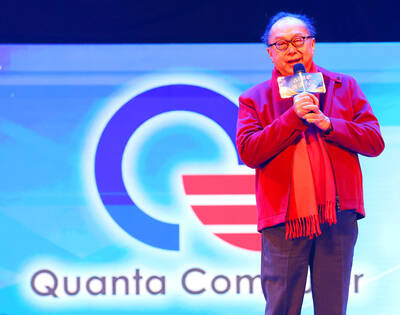Let us be clear about one thing: That SpaceX rocket launch on Tuesday was incredible. Putting a Tesla Roadster into orbit atop it was a stroke of marketing genius; imagine the slogan: “A bazillion miles without a charge!”
Let us also be clear about another thing: This has nothing to do with Tesla Inc’s performance as a company, even if the stock market sometimes implies otherwise. On that front, 100,000 Tesla Model 3s idling on lots near Fremont, California, would be worth far more than one electric sportscar headed for the asteroid belt.
Alas, no such luck. A day after deserved jubilation in Cape Canaveral, Florida, it was back to the relatively mundane task of reporting Tesla’s quarterly results.

Photo: AP
The big question was whether Tesla would shift its production target for the Model 3 back — again. It did not, thankfully.
However, as is often the case with the company, there are caveats.
“It is important to note that while these are the levels we are focused on hitting and we have plans in place to achieve them, our prior experience on the Model 3 ramp has demonstrated the difficulty of accurately forecasting specific production rates at specific points in time,” Tesla said.
In other words, Tesla’s ambitions for the Model 3 remain intact, but please bear in mind that such ambitions have proved, on prior occasions, somewhat overambitious. There was no update on the current production rate, despite repeated questions on Wednesday evening’s call, which is troubling.
A month earlier, Tesla claimed it had hit a pace that “extrapolates” to more than 1,000 vehicles per week. Whatever that meant exactly, it does not appear to have been sustained, at least according to sales estimates by InsideEVs: They put last month’s Model 3 deliveries at a little less than 1,900 overall.
Getting the Model 3 production line fixed is critical if this year is to be, as Tesla puts it with typical restraint, “a transformative year.”
All that installed capital producing a trickle of vehicles trashes Tesla’s gross profit margin. The 18.9 percent headline margin for the automotive business was weak. Yet even that owed a lot to Tesla selling the largest slug of zero-emission vehicle credits for any quarter ever.
Tesla is struggling with what every Silicon Valley company taking its moonshot must ultimately do: scale. It expects to sell 100,000 Model S and X vehicles this year, meaning zero growth on that front. And even as Tesla boasts of growth on every other front, there is precious little to show for it in terms of operating leverage.
For example, revenue jumped by 44 percent annually in the fourth quarter of last year. Yet the company’s gross profit increased by less than 1 percent and its net loss more than tripled to its worst ever.
What this ultimately comes back to is cash. On that front, Tesla actually came in much better than forecasts, with negative free cash flow just US$277 million against a consensus figure of US$901 million. But again: caveats, folks.
First of all, definitions: Tesla does not count spending on solar energy systems to be leased as capital expenditure. This is understandable up to a point, but they eat up significantly more than US$100 million per quarter and should be counted somewhere.
Second, Tesla counts customer deposits as operating cash flow, even though these are refundable and, in essence, zero-interest short-term loans.
Still, let us assume the deposits are money in the bank. They jumped by US$168 million in the quarter, which is a good thing and reflects, at least in part, the addition of deposits for Tesla’s new semi truck and updated Roadster.
Another big factor was negative working capital, contributing almost US$500 million. More than 40 percent of that reflected running down inventories — as Tesla slowed production across the board in the quarter — and about another 20 percent was due to a drop in accounts receivable.
Capital expenditure came in well below the consensus forecast, at US$787 million — not counting solar-energy equipment — rather than the US$1 billion expected. Yet, as Tesla said, that reflected some Model 3-related capital expenditure being deferred.
This is all somewhat reminiscent of the third quarter of 2016, when a big favorable swing in working capital, relatively low capital expenditure and a jump in sales of emissions credits helped Tesla “throw a pie in the face of all naysayers on Wall Street,” to use chief executive officer Elon Musk’s phrase. As then, most of these factors are not repeatable.
Tesla expects capital expenditure this year to exceed last year’s US$3.4 billion, which happens to equal the amount of cash Tesla has in the bank. This, more than anything, is why Tesla must hit its stride on the Model 3. Otherwise, raising more capital could be unavoidable in the second half of the year.
On that front, Tesla has shown a talent for tapping different sources, such as last summer’s high-yield bond issue.
However, this also comes at a cost: The company’s annual interest expense more than doubled last quarter and equates, remarkably, to one-thirds of gross profit.
Tesla had best reach escape velocity soon.
Liam Denning is a Bloomberg Gadfly columnist covering energy, mining and commodities. He previously was the editor of the Wall Street Journal’s “Heard on the Street” column. Before that, he wrote for the Financial Times’ “Lex” column. He has also worked as an investment banker and consultant.
This column does not necessarily reflect
the opinion of Bloomberg LP and its owners.

Intel Corp chief executive officer Lip-Bu Tan (陳立武) is expected to meet with Taiwanese suppliers next month in conjunction with the opening of the Computex Taipei trade show, supply chain sources said on Monday. The visit, the first for Tan to Taiwan since assuming his new post last month, would be aimed at enhancing Intel’s ties with suppliers in Taiwan as he attempts to help turn around the struggling US chipmaker, the sources said. Tan is to hold a banquet to celebrate Intel’s 40-year presence in Taiwan before Computex opens on May 20 and invite dozens of Taiwanese suppliers to exchange views

Application-specific integrated circuit designer Faraday Technology Corp (智原) yesterday said that although revenue this quarter would decline 30 percent from last quarter, it retained its full-year forecast of revenue growth of 100 percent. The company attributed the quarterly drop to a slowdown in customers’ production of chips using Faraday’s advanced packaging technology. The company is still confident about its revenue growth this year, given its strong “design-win” — or the projects it won to help customers design their chips, Faraday president Steve Wang (王國雍) told an online earnings conference. “The design-win this year is better than we expected. We believe we will win

Power supply and electronic components maker Delta Electronics Inc (台達電) yesterday said it plans to ship its new 1 megawatt charging systems for electric trucks and buses in the first half of next year at the earliest. The new charging piles, which deliver up to 1 megawatt of charging power, are designed for heavy-duty electric vehicles, and support a maximum current of 1,500 amperes and output of 1,250 volts, Delta said in a news release. “If everything goes smoothly, we could begin shipping those new charging systems as early as in the first half of next year,” a company official said. The new

Quanta Computer Inc (廣達) chairman Barry Lam (林百里) is expected to share his views about the artificial intelligence (AI) industry’s prospects during his speech at the company’s 37th anniversary ceremony, as AI servers have become a new growth engine for the equipment manufacturing service provider. Lam’s speech is much anticipated, as Quanta has risen as one of the world’s major AI server suppliers. The company reported a 30 percent year-on-year growth in consolidated revenue to NT$1.41 trillion (US$43.35 billion) last year, thanks to fast-growing demand for servers, especially those with AI capabilities. The company told investors in November last year that